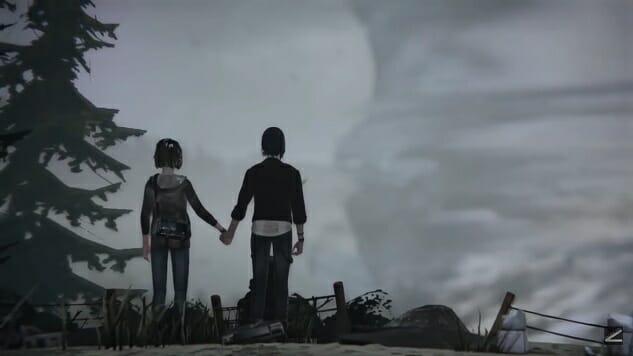Life is Strange Episode 5: The Love You Take

When people ask me about high school, I always say how much I would like to go back and change things. I would like to be more outspoken, dress better, talk to people more, take chances, maybe be remembered for something other than being that weird girl who often cried at her desk. I have a lot of regrets that don’t include killing my best friend or destroying a town, so I’m sure it’s worse for Max Caufield, who, throughout five episodes of Life is Strange, is simultaneously improved and broken. But there’s very little I, or Max, can do about it. I can only improve myself later.
Max has gone through a lot. She’s watched her best friend die, seen classmates contemplate and attempt suicide, and seen people she once trusted betray her, all because she wanted things to be just a little different. The experience has never been about trying to find the source of her time traveling powers or figuring out how to stop the tornado from tearing up Arcadia Bay. It was never about the ethical dilemmas involved with actively manipulating people into doing what you want (although that is a part of it). It was about learning that you don’t have control over the things that happen and you can’t always make the right decisions and how that’s not a bad thing. There’s something very human about Max’s struggle, and not just with her powers, but in her journey to make sense of being a teenager.
And so it is in the game’s fifth episode “Polarized” that the developers effectively punish those who don’t understand that message. In a way, the final choice is a test. Without spoilers, both of them are logical choices, but only one is correct. Life is Strange started every chapter with the term “choose wisely” and never has it been more true than in the final few minutes. Make one choice and you get a satisfying conclusion that not only shows that Max has matured and accepted the consequences of mundanity, but also that the world is a place of balance and pain that is at once beautiful and terrifying. Make the other and you’ll feel a little sick to your stomach, a little angry, and a bit empty.
Life is Strange is cliché in this regard. Most time travel stories are about hubris and about the inevitability of fate getting its way. Doctor Who, for example, is constantly hammering the point home that despite the omnipotence of its protagonist, you can’t stop things like destruction, war and darkness from occurring. The Final Destination franchise is about how you can’t cheat death. The Butterfly Effect is a more obvious comparison, especially considering how Max’s powers are spurred on by the appearance of a butterfly, but it’s all the same. Life is Strange was going to end in the same place from the beginning. It’s a shame that, at the time of my playthrough, nearly half had decided to make the wrong choice, erasing what the game was trying to accomplish and what had been hinted at since the first time Max turned back the clock.
But what would cause so many people to make that choice? Well, it’s about Chloe, so I get it.
Studio Dontnod’s greatest achievement with the game has been in the creation and development of its characters, in how genuine Chloe and Max feel despite some trashy dialogue and some questionable moments. In the first couple of episodes, it seemed like Chloe would be a damsel for Max to save, an unruly force that did nothing but cause destruction as her punk persona would dictate. Gratefully, Chloe was able to overcome those stereotypes and become a true friend to Max. Not only was she a shoulder to cry on, but she was a productive member of the investigative team, helping to uncover the mystery of Blackwell Academy. As Max’s psyche begins to unravel, Chloe is there to stabilize her. As otherworldly as Max’s powers are, and as illogical as they become in later episodes, Chloe manages to remind Max what this is all about.
-

-

-

-

-

-

-

-

-

-

-

-

-

-

-

-

-

-

-

-

-

-

-

-

-

-

-

-

-

-

-

-

-

-

-

-

-

-

-

-








































